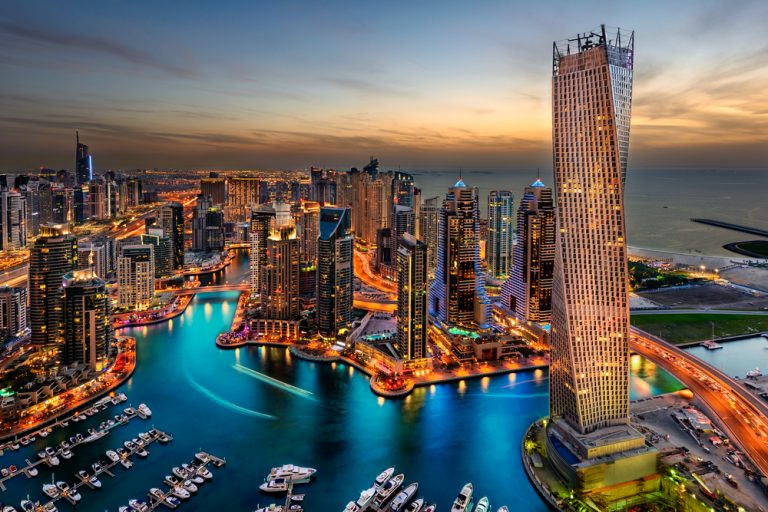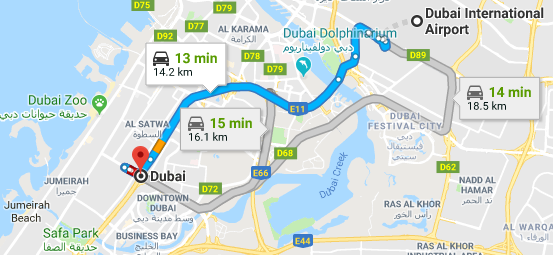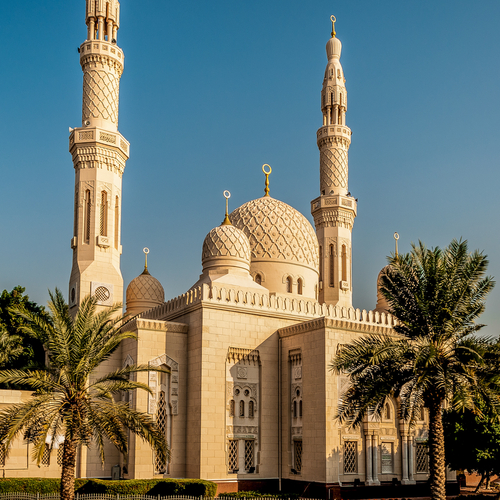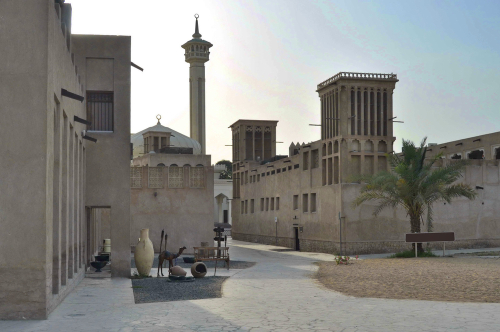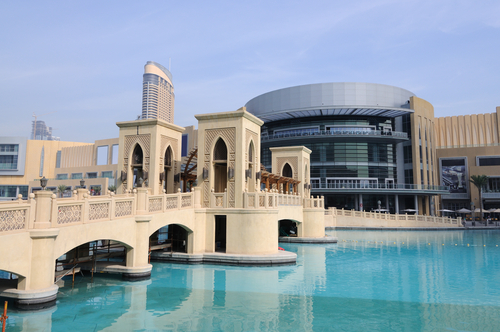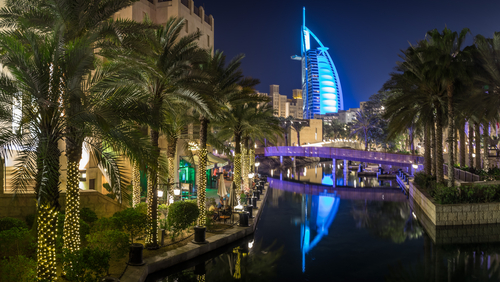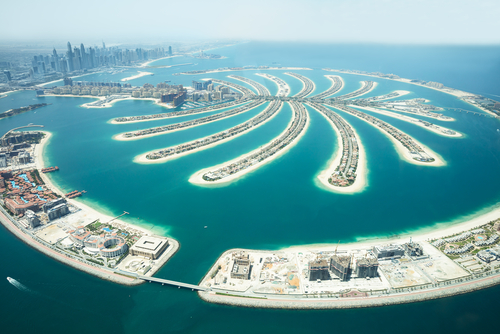Standing on the Persian Gulf in the south-east of the Arabian Peninsula lie seven emirate states which were formerly British protectorates. In 1971 they joined together to form the country which we now know as the United Arab Emirates. The Emirate of Dubai is the 2nd largest of these former Trucial States, its capital is the city of Dubai which is the leading centre for business and tourism in the Middle East.
Home to the world’s tallest building, most luxurious hotel and patrolled by police officers driving Ferraris, there is little on the surface which isn’t ostentatious about Dubai. Yet contrary to popular belief this wealth is not based entirely on the oil industry. Back in the 1830s the city had already established itself as a regional trading port which would become an important centre for gold trading by the turn of the century. The discovery of oil in 1966 speeded up development and infrastructural investment set the foundation for the wealthy state we see today.
Unlike the rest of the United Arab Emirates, Dubai is not dependent on revenue from oil exports. Its economy is largely based on service industries of which tourism plays a key role. Beautiful beaches, man-made island resorts, stunning hotels, tax-free shopping malls and a pleasant winter climate have all contributed to making Dubai the world’s fourth most visited city.
Port of Dubai
At the moment cruise ships visiting Dubai dock at one of the three interconnected cruise terminals at Port Rashid which currently caters for around 650,000 passengers per year. Most important of these terminals is the luxurious Terminal 3 which is more formerly known as Hamdan bin Mohammed Cruise Terminal. Redevelopment of this terminal will see it replace the other two by 2020 and become the world’s largest cruise terminal dealing with around a million passengers per year.
The cruise season in this part of the world runs from October to May with Dubai serving as an embarkation port for many Middle Eastern voyages. As such the majority of passengers spend a night or two in Dubai at the beginning or end of their trip.
Transport From Dubai Airport
Passengers who are beginning or ending a cruise in Dubai will travel through Dubai International Airport which lies just 14km east of the cruise terminal. Plenty metered taxis are available from the airport terminals for the 25 minute drive to the port. Alternatively, private transfers from Dubai Airport can be pre-booked to Port Rashid or to hotels throughout the city.
A small number of seasonal services arrive at Al Maktoum International Airport which lies 65km south-west of Port Rashid. Shuttledirect can also provide airport transfers into Dubai City and to the cruise port from this airport.
Getting Around in Dubai
Walking: It’s a significant distance from the cruise ship terminals to the port exit so walking is not an option. In addition, tourist attractions within the city tend to be some distance apart and daily temperatures are usually very hot so again walking cannot be recommended.
Shuttle Buses: Some cruise ships offer shuttle transfers into the downtown area otherwise there are free shuttles to some of the less well-known shopping malls which can be arranged from desks inside the cruise terminal. Paid shuttle buses are also available to the famous Dubai Mall.
Taxis: There are plenty metered city taxis available which apply a surcharge for fares from the cruise terminal. It’s often a good idea to take a free shuttle to one of the shopping malls then use taxis to get around other city attractions.
Hop-on, Hop-off Buses: These tourist buses stop outside each of the cruise terminals and are a great way to get around all the sights of Dubai. Highly recommended are the 48-hour tickets which include transport on evening services. They can be purchased online in advance or from information booths inside the terminals.
Public Transport: Getting around the city by means of the excellent metro system is far quicker than on the congested roads, however, the stops are often some distance from tourist attractions so some walking or taxi journeys may be necessary. The best way to access the metro from the cruise terminal is to take a taxi or shuttle bus to Burjuman shopping mall which is next to the Khalid Bin Walid metro station. The most convenient ticket for getting around is the electronic Nol Card which allows for travel on all metro and bus services.
Main Tourist Attractions
Historic Dubai:
Before heading off to see the city’s iconic skyscrapers and huge, tax-free shopping malls it’s worth spending some time discovering a little bit about the history of Dubai.
A good place to start is at the Dubai Creek in the heart of the city which effectively divides the city’s business centre (Deira) from its historic district (Bur Dubai). The latter is home to the Grand Bur Dubai Masjid which is the city’s Grand Mosque. Originally built in 1900 it is one of the largest mosques in the United Arab Emirates which has the city’s tallest minaret standing at 70m. Non-muslims are not permitted to enter the mosque.
Other nearby attractions include the Hindu Temple and the excellent Dubai Museum which describes how the city rapidly evolved from a fishing village to a major world city in such a short time. Just west of the museum is the Textile Souk which is a great place to pick up souvenirs from the many colourful items on display.
To the east of the Dubai Museum lies the fascinating Al Fahidi Historical District (Bastakiya) which has been preserved to show visitors how the city looked in the mid-19th century. Nearby is the Sheikh Mohammed Centre for Cultural Understanding which is dedicated to providing education on the culture of the UAE and removing cultural barriers.
Towards the mouth of the Dubai Creek stands the opulent House of Sheikh Saeed Al Maktoum. Formerly the home of a 19th century leader of Dubai it now serves as a museum which exhibits many items from Dubai’s pre-oil era. Visitors can take a water-taxi known as an ‘abra’ across the Dubai Creek to the Deira district which is home to some of the city’s traditional markets including the Gold Souk and the Spice Souk.
Shopping Malls:
In sharp contrast to the historic textile, gold and spice markets are the modern-day shopping malls which are major tourist attractions in their own right. As well as housing thousands of retail outlets these establishments are home to the many of the world’s best-known chain restaurants together with cinemas, banks and all kinds of recreational facilities.
The most famous is the enormous Dubai Mall (Financial Center Road) which has more than 1300 shops within its walls and is the world’s most visited building with over 50 million annual visitors. In addition to more than 200 food outlets the mall is also home to the Dubai Aquarium, an Olympic-size ice rink and the incredible Dubai Fountain which is the world’s tallest performing fountain.
Some 15km to the south-west of the Dubai Mall lies the Mall of the Emirates which is perhaps the city’s second best-known shopping mall. As well as hundreds of retail outlets and many restaurants the building is also home to Ski Dubai which is one of the world’s largest indoor ski resorts.
Iconic Buildings:
Standing at almost 830m the most famous sight on Dubai’s skyline is the Burj Khalifa which is the world’s tallest building. Its fame was enhanced worldwide in 2011 when Tom Cruise was seen scaling the building in his blockbuster movie ‘Mission: Impossible Ghost Protocol’. The entrance to the building is from the ground floor of the Dubai Mall from where visitors can buy tickets to go up to the observation deck on the 124th floor. This is one of the city’s main tourist attractions from where visitors can watch the choreographed Dubai fountain show down below. A higher observation deck is also accessible on the 148th floor.
The other main building which is synonymous with Dubai is the iconic Burj Al Arab Jumeirah which stands on the offshore island of Palm Jumeirah. This 27-floor, sail-shaped hotel is the self-proclaimed most luxurious hotel in the world. Casual visits to the hotel aren’t permitted although non-guests can reserve tables at the hotel’s restaurants.
Shore Excursions in Dubai
Whilst the historic centre of Old Dubai together with the shopping malls and iconic buildings will provide cruise ship passengers with plenty to keep them busy there are some additional attractions if time permits:
Dubai Palm Islands: Located off the coast of Dubai to the south of the cruise port these three man-made islands are designed in the shape of palm trees. Created from reclaimed land they are home to thousands of villas and apartments together with luxury hotels (including the Burj Al Arab Jumeirah), shopping malls, marinas, recreational facilities and restaurants. Cruise ship passengers can buy a day pass to visit Palm Jumeirah then travel there by means of a monorail from the mainland. Development of the other two islands together with another ambitious offshore development project called ‘The World’ has been delayed due to the 2008 world financial crisis.
Dubai Desert Safari: Probably the most exciting activity for cruise ship passengers is a desert safari which begins with a transfer from the cruise port into the desert by means of a 4 x 4 vehicle. Once arrived at their destination these vehicles with their professional drivers take passengers on a thrilling journey through the sand dunes. Other activities which are typically made available include camel rides, sand boarding and belly dancing shows with the tour often ending with a barbecue at a desert camp location.
Wild Wadi Water Park: Located in the Jumeirah area of the city this waterpark which has about 30 different rides provides a welcome break from the heat of the city. To keep things nice and cool the park’s water temperature is manually regulated according to the day’s air temperature.
Overnight in Dubai
Many cruise ship passengers will have overnight stays in Dubai at the beginning or end of their itinerary. The restaurants and recreational facilities provided by the main shopping malls provide ample entertainment options for the majority of overnight visitors, however, there are some activities which are a little out of the ordinary:
Ethnic Food Tours: The population of Dubai is approximately 2.5 million of which 85% are immigrants. Rather than dining at any one of the soulless chain restaurants in the shopping malls it’s a good idea to sign-up for a walking tour of some of the city’s ethnic eateries. These tours introduce visitors to an incredible range of street food from the Middle East and the Indian sub-continent.
Sunset at the Top of the Burj Khalifa: A wonderful early evening experience in Dubai is to pre-book a time-controlled ticket for the viewing platforms of the world’s tallest building. Get there just before sunset and enjoy the amazing light and water show from the Burj Khalifa Lake below then marvel at the beautiful sunset. Afterwards you can dine at one of the many restaurants inside the Dubai Mall.
Overnight Desert Safari: Daytime desert safaris are a popular shore excursion for many cruise ship passengers. However, for something that little bit special when staying overnight in Dubai you can arrange to enjoy all the usual activities of the tour then spend the night at a Bedouin camp in the desert. The tour operator then returns guests to their ship the following morning.
About Shuttle Direct
Shuttle Direct is the most established and respected airport transfer provider in Europe and northern Africa. Our friendly local drivers will ensure your safe, economical, and convenient passage to and from the cruise terminal, airport, or major train station of your choice with a minimum of fuss. Book your transfer with our easy to use online booking system and leave the rest up to us!

